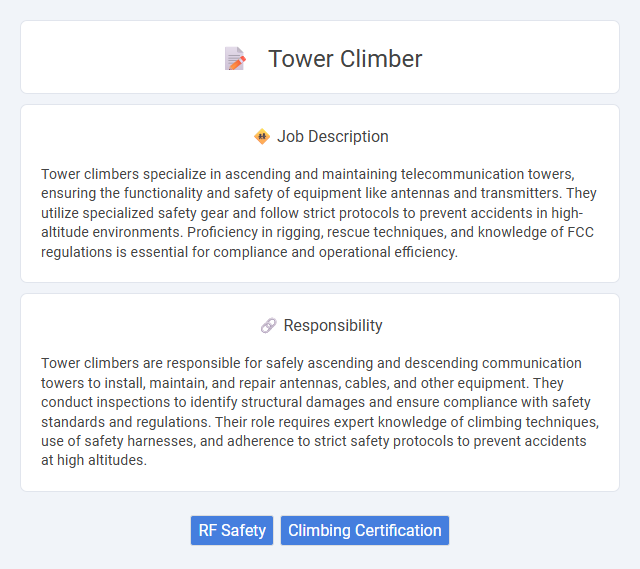
Tower climbers specialize in ascending and maintaining telecommunication towers, ensuring the functionality and safety of equipment like antennas and transmitters. They utilize specialized safety gear and follow strict protocols to prevent accidents in high-altitude environments. Proficiency in rigging, rescue techniques, and knowledge of FCC regulations is essential for compliance and operational efficiency.
Tower climbers are likely suited for individuals with strong physical fitness, excellent balance, and a high tolerance for heights and confined spaces. They may face challenging weather conditions and require a high level of mental resilience to handle the risks involved in working at extreme elevations. Those with a fear of heights or limited endurance might probably find this job unsuitable.
Qualification
Tower climbers must possess specialized training in tower safety protocols, fall protection, and rescue techniques to ensure compliance with OSHA standards. Certification in First Aid and CPR is often required, along with physical fitness to handle the demanding nature of climbing and working at heights. Experience with electrical systems, rigging, and equipment maintenance enhances a tower climber's qualifications for installation, repair, and inspection tasks.
Responsibility
Tower climbers are responsible for safely ascending and descending communication towers to install, maintain, and repair antennas, cables, and other equipment. They conduct inspections to identify structural damages and ensure compliance with safety standards and regulations. Their role requires expert knowledge of climbing techniques, use of safety harnesses, and adherence to strict safety protocols to prevent accidents at high altitudes.
Benefit
Tower climber jobs likely offer substantial financial benefits, including competitive salaries and overtime pay due to the high-risk nature of the work. Employees may also receive health and safety training that enhances their skill set and job security. The role could provide opportunities for career advancement within the telecommunications and utilities industries.
Challenge
Tower climber jobs often involve working at significant heights, which likely presents considerable physical and mental challenges. The probability of encountering unpredictable weather and technical difficulties means that climbers must maintain high levels of safety awareness and problem-solving skills. These challenges could lead to a rewarding sense of accomplishment for those who thrive in demanding environments.
Career Advancement
Tower climbers skilled in high-elevation maintenance and safety protocols often progress to supervisory roles or specialized technical positions in telecommunications infrastructure. Mastery of rigging, rescue, and installation techniques enhances prospects for becoming project managers or safety trainers within the industry. Continuous certification in OSHA standards and advanced climbing technologies significantly accelerates career growth and salary potential.
Key Terms
RF Safety
Tower climbers working in telecommunications must adhere to strict RF safety protocols to minimize exposure to radiofrequency radiation from antennas and transmitters. Proper use of personal protective equipment (PPE), regular training on RF hazard recognition, and adherence to industry standards like IEEE C95.1 ensure compliance and worker safety. Monitoring RF exposure levels using specialized equipment is essential to prevent acute and chronic health risks associated with high-frequency electromagnetic fields.
Climbing Certification
Tower climbers require specialized Climbing Certification to ensure safety and efficiency when working at heights typically ranging from 100 to 300 feet. Certifications such as the OSHA 29 CFR 1910.269 and ANSI/ASSE A10.32-2012 provide essential training in fall protection, rescue procedures, and equipment handling. Obtaining these credentials is critical for compliance with industry standards and reducing risks associated with tower maintenance and installation tasks.
 kuljobs.com
kuljobs.com